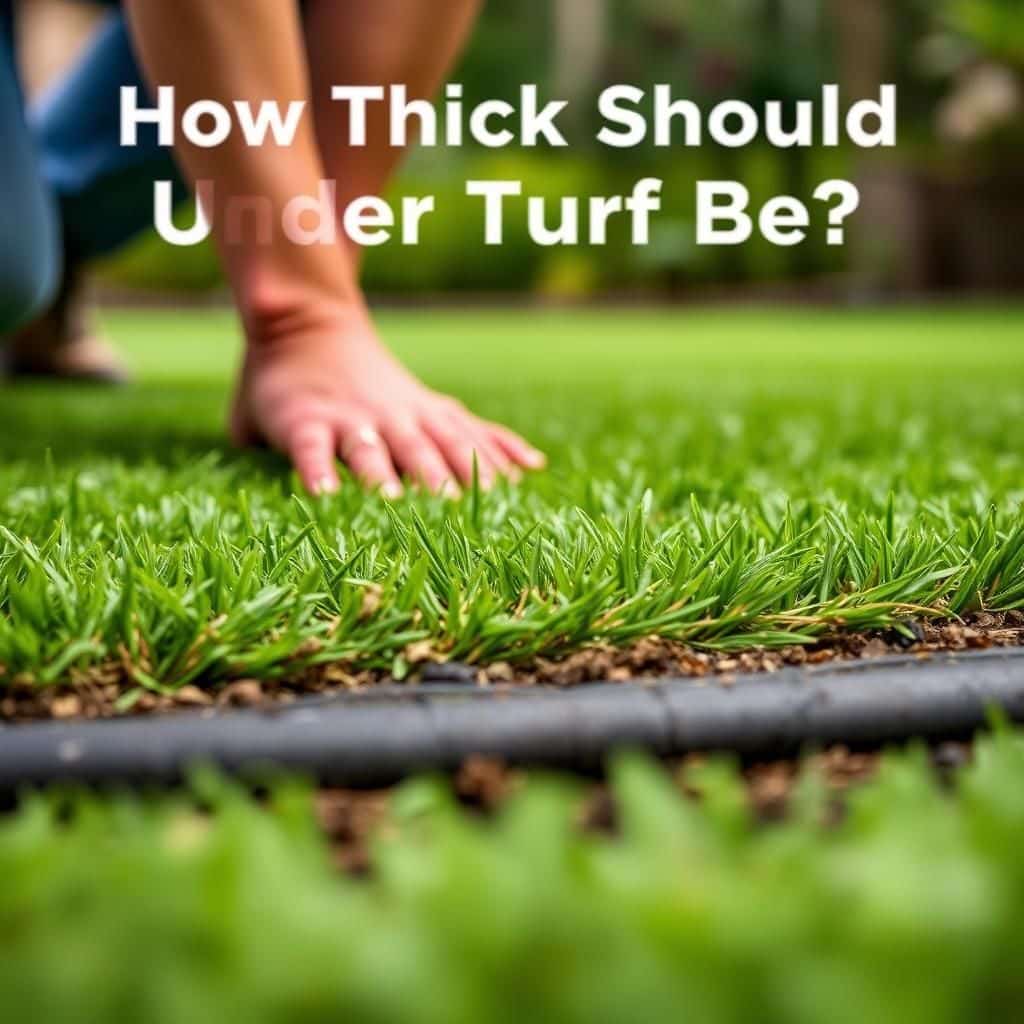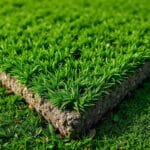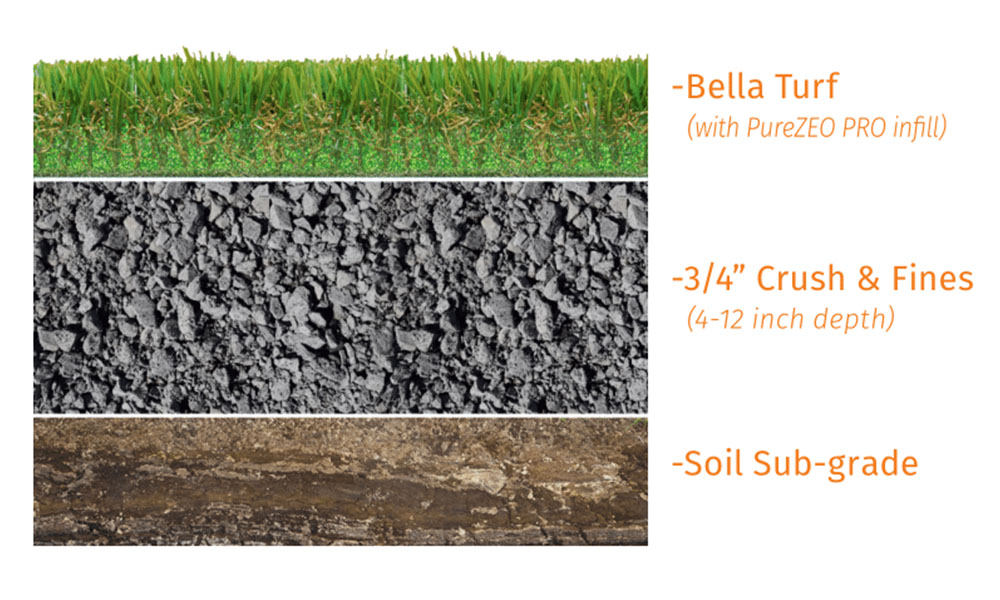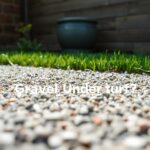How Thick Should Under Turf Be? Expert Tips for Optimal Lawn Installation

When installing a new lawn, one of the most critical factors to consider is the thickness of the under turf. The right depth can significantly influence the health and longevity of your grass, providing necessary support for root development and moisture retention. However, many homeowners are uncertain about the optimal thickness for their specific environment and grass type. In this article, we will explore expert tips and guidelines to help you determine how thick your under turf should be for a successful lawn installation. Understanding this aspect will ensure your lawn thrives, enhancing both its appearance and durability.
Optimal Thickness for Under Turf Installation
To ensure a healthy and thriving lawn, the recommended thickness for under turf should typically be between 3 to 5 inches of high-quality topsoil or a suitable growing medium. This depth allows for adequate root development, drainage, and aeration, which are vital for grass health. A thicker layer, particularly in areas with poorer soil quality, can help retain moisture and provide the necessary nutrients for the grass. It is essential to assess the existing soil conditions before installation, as this can impact the choice of thickness to achieve optimal results.
Factors Influencing Under Turf Thickness
Several factors influence the ideal thickness for under turf, including the type of grass being planted, the climate, and the existing soil conditions. Different grass species have different root structures and growth requirements, which can dictate the necessary soil depth. Additionally, regions with heavy rainfall may require deeper soil layers for better drainage, while arid areas might not need as much depth due to reduced moisture retention needs.
Benefits of Proper Thickness
Having the correct thickness of under turf provides numerous benefits such as improved water retention, enhanced nutrient availability, and better aeration for grass roots. A well-prepared base allows for fewer compaction issues and promotes a healthier lawn overall. Moreover, proper thickness minimizes the impact of temperature fluctuations, providing a more consistent environment for grass growth.
Common Mistakes in Installation
One common mistake during turf installation is not adequately assessing the existing soil before adding under turf layers. Many homeowners add topsoil without considering how compacted or unhealthy the underlying layer may be. This can lead to insufficient drainage or even root rot if water cannot move effectively. Additionally, neglecting to level the ground or not applying the correct thickness can result in uneven grass growth, which detracts from the overall appearance of the lawn.
Tools Needed for Measuring Thickness
To ensure the correct thickness of under turf is achieved, several essential tools can be utilized. A measuring tape is crucial for determining the depth of the soil before laying down the turf, while a spirit level helps ensure that the ground is even and properly prepared. Additionally, a soil probe can be handy to assess the quality and condition of the existing soil, which is essential when determining how much additional topsoil is needed.
Maintenance Tips for Under Turf
Once the under turf is installed, ongoing maintenance is essential to maintain its thickness and health. Regularly aerating the soil helps to relieve compaction, which can develop over time and inhibit grass growth. Additionally, keeping up with soil amendments and ensuring that the turf receives adequate water and nutrients will support the health of the under turf. A combination of these practices will contribute to a lush, green lawn that withstands various environmental stresses.
| Factor | Ideal Thickness |
|---|---|
| Healthy Soil | 3-4 inches |
| Problematic Soil | 4-5 inches |
| Type of Grass | 3-5 inches |
| Climate Considerations | 3-6 inches |
How thick should a turf base be?

The thickness of a turf base is crucial for ensuring a healthy and durable lawn. Generally, a turf base should be between 3 to 6 inches thick, depending on several factors such as soil type, drainage capabilities, and the intended use of the grass.
Understanding Turf Base Thickness
The thickness of the turf base plays a significant role in the establishment and longevity of the grass. A properly thick base aids in root development, moisture retention, and nutrient availability. Here are some important points to consider:
- Root Development: A thicker base allows for deeper root systems.
- Drainage: Adequate thickness helps promote better drainage, preventing waterlogging.
- Nutrient Access: A deeper substrate allows grass roots to access more nutrients from the soil.
Factors Influencing Base Thickness
Several factors can impact the ideal thickness of your turf base. These include soil characteristics, climate, and grass species. Each factor can alter the necessary thickness for optimal growth:
- Soil Type: Sandy soils may require less thickness, while clay soils often need thicker bases for drainage.
- Climate Conditions: In drier climates, deeper bases may help retain moisture.
- Grass Variety: Different grass types have varying root depth requirements, which can affect base thickness.
Choosing the Right Installation Depth
When installing turf, selecting the right base depth is essential for the overall success of your lawn. Properly measuring and preparing the base will ensure the longevity and health of your turf:
- Measurement: Use a level to ensure an even base across the installation site.
- Site Preparation: Clear debris and weeds for a clean installation.
- Layering: Consider using a mix of soil types to enhance drainage and nutrient retention.
Maintenance of Turf Base Thickness
Once your turf is installed, it is important to maintain the proper thickness through regular care. Over time, grass can thin out, or soil can compact, affecting the base thickness:
See also:
- Regular Aeration: Aerate the lawn to relieve compaction and improve root depth.
- Top-Dressing: Apply organic materials periodically to maintain a maximum thickness of nutrient-rich soil.
- Watering Practices: Implement appropriate watering to prevent the soil from becoming compacted or eroded.
Common Mistakes in Turf Base Thickness
There are several common mistakes made when determining and preparing the turf base thickness. Being aware of these can lead to better outcomes for your lawn:
- Inconsistent Depth: Not maintaining a uniform depth can lead to uneven grass growth.
- Neglecting Drainage: Failing to consider drainage needs can cause water issues.
- Ignoring Soil Health: Not assessing soil quality can result in poor nutrient availability.
How much base do you need under turf?

To ensure proper installation and longevity of turf, it is crucial to establish the right base beneath it. The general standard for a base under turf typically ranges from 3 to 6 inches. However, specific conditions and intended use cases can affect this measurement. Here are some detailed considerations:
Understanding the Purpose of a Base Layer
The base layer serves multiple functions in turf installation. It provides stability, promotes drainage, and enhances root growth. Understanding these purposes can help in determining the necessary thickness:
- Stability: A solid base helps to distribute weight and prevents uneven settling.
- Drainage: Properly layered base allows rainwater to drain away, reducing pooling and root rot.
- Root Growth: A well-aerated base encourages healthy root development, maximizing the lifespan of the turf.
Factors Influencing Base Thickness
Several factors can influence how thick your base should be when installing turf. Each project may call for unique adjustments:
- Soil Type: Clay soil retains water and may require a deeper base for adequate drainage.
- Traffic Level: High-traffic areas might need a thicker base to withstand wear and tear.
- Climate: Regions with heavy rainfall may necessitate a deeper drainage system within the base.
Components of an Ideal Base Layer
An ideal base layer consists of various materials that enhance its effectiveness. The choice of materials is essential to achieve desired outcomes:
- Crushed Stone: Provides excellent drainage and stability, making it a common choice for bases.
- Sand: Often used to improve drainage and prevent compaction.
- Soil Mix: Incorporating a balance of soil and compost can promote better root growth.
Preparation and Installation of the Base
Preparing and installing the base is a vital step in ensuring a successful turf installation. Here is how to do it effectively:
- Excavation: Remove existing grass and soil to the necessary depth, ensuring a level ground.
- Layering: Add the base materials in layers, compacting each layer for stability.
- Leveling: Use a rake to ensure the surface is flat, smooth, and even before laying the turf.
Maintenance of the Base Layer
After installation, maintaining the base layer is crucial for the long-term health of your turf. Here are some maintenance tips:
- Regular Checks: Inspect the base for any signs of settling or unevenness, especially after heavy rains.
- Drainage Cleaning: Ensure that drainage paths are clear to prevent water accumulation.
- Top-Dressing: Periodically add a thin layer of soil or sand to replenish the base and improve root growth.
How deep should the base be for artificial turf?

To determine how deep the base should be for artificial turf, several factors must be taken into account, including soil conditions, usage, and drainage requirements. Generally, a recommended depth for the base is between 4 to 12 inches, depending on the specific needs of the project.
Importance of Proper Base Depth
Using the correct base depth for artificial turf is essential to ensure optimal performance and longevity. A well-constructed base provides several benefits:
- Stability: It ensures a solid foundation that prevents the turf from shifting or settling.
- Drainage: Adequate depth allows for proper water drainage, preventing issues such as puddling or sogginess.
- Durability: A robust base reduces wear and tear on the turf, extending its lifespan.
Factors Affecting Base Depth
Several factors affect the required depth of the base for artificial turf installations:
- Soil Type: Sandy soils may require less depth compared to clay soils, which retain moisture.
- Intended Use: High-traffic areas, like sports fields, may need a deeper base for added support.
- Weather Conditions: Regions with heavy rainfall may need a deeper base for better drainage solutions.
Recommended Base Materials
The materials used for the base significantly influence its effectiveness and longevity:
See also:
- Crushed Stone: Provides excellent drainage and stability.
- Granular Base: This is a mixture of sand and gravel ideal for compacting and strength.
- Geotextiles: Using fabric layers can prevent weed growth and maintain base integrity.
Installation Process of the Base
The installation of the base involves several steps that must be closely followed:
- Excavation: Digging to the appropriate depth based on the planned use and conditions.
- Compaction: Compacting the soil and base materials to create a stable surface.
- Leveling: Ensuring the surface is level and properly sloped for drainage.
Maintenance of the Base
Maintaining the integrity of the base is crucial for the long-term performance of artificial turf:
- Regular Inspections: Checking for settling or erosion to ensure continued stability.
- Weed Management: Preventing weeds from disrupting the base structure.
- Drainage Maintenance: Ensuring that drainage systems remain clear to prevent water accumulation.
What is best to lay under turf?

To create a healthy and sustainable environment for turf, it is essential to lay down the appropriate materials beneath it. The best options to lay under turf contribute to root development, drainage, and overall grass health. Here are some of the most beneficial materials to consider:
Soil Preparation
To ensure optimal growth conditions for grass, soil preparation is crucial. Properly amended soil enhances drainage and provides essential nutrients. Attention should be given to the following aspects:
- Soil Testing: Conduct a soil test to gauge pH levels and nutrient content.
- Amendments: Add organic matter like compost to improve soil structure and fertility.
- Tilling: Till the top 6-8 inches of soil to aerate and mix amendments thoroughly.
Drainage Layers
A well-designed drainage layer prevents waterlogging and promotes healthy root systems. It is important for the following reasons:
- Water Management: Ensure excess water can flow away from the roots.
- Material Choice: Consider using materials like gravel or sand to create a drainage layer.
- Installation: Slant the drainage layer away from structures to direct water away from vulnerable areas.
Weed Barrier
Implementing a weed barrier can prevent unwanted weeds from establishing underneath the turf. This serves to maintain the turf's health and aesthetics:
- Geotextile Fabric: Use permeable fabrics that allow air and water but block weed growth.
- Installation Technique: Lay the fabric over the soil after preparation, making sure to overlap edges.
- Maintenance: Monitor and replace the barrier as necessary to ensure it remains effective.
Nutrient Layer
Incorporating a nutrient layer beneath the turf can significantly influence its vitality and growth rate. Key components include:
- Fertilization: Apply a slow-release fertilizer to provide essential nutrients over time.
- Organic Additives: Utilize organic options such as manure or worm castings for natural fertilization.
- Timing: Fertilize before laying turf for immediate access to necessary nutrients.
Compaction Level
Compaction influences water retention and root growth. Understanding and managing compaction is vital for turf health:
- Initial Compaction: Lightly compact the soil after preparation to create a stable surface for turf.
- Aeration: Aerate the soil periodically to relieve excess compaction and improve drainage.
- Monitoring: Keep an eye on soil density, especially in high-traffic areas, and aerate as needed.
Questions from Our Readers
How thick should under turf be for optimal growth?
The thickness of the under turf should ideally be around 4 to 6 inches. This depth allows for sufficient root penetration and provides the necessary nutrients and moisture for the grass, promoting overall healthy growth.
What materials are recommended for under turf?
It's best to use a mix of topsoil, sand, and compost for the under turf. This combination improves drainage, enhances nutrient availability, and supports better root development, leading to a more vibrant lawn.
Can the thickness of under turf vary for different grass types?
Yes, the required thickness can vary depending on the grass type. For instance, cool-season grasses may thrive with a slightly thicker layer, while warm-season grasses might require a shallower base to establish roots effectively.
What happens if the under turf is too thin?
If the under turf is too thin, it can lead to poor root establishment, limited nutrient access, and increased vulnerability to weeds or pests. This can ultimately result in a weaker lawn that struggles to thrive or sustain itself.
See also:

If you want to read more articles like How Thick Should Under Turf Be? Expert Tips for Optimal Lawn Installation, we recommend you check out our Turf category.
Leave a Reply
Related Articles